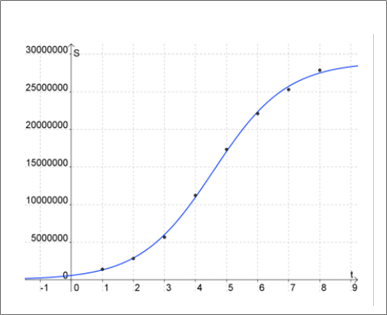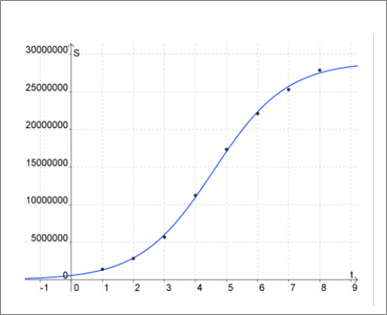
Concept explainers
a.
To find: the logistic regression for the data.
a.
Answer to Problem 32E
Explanation of Solution
Given information: Table shows the cumulative number of subscriber added to tat.
baseline number from 1978 to 1985.
| Year since 1977 | Added Subscribers Since 1977 |
| 1 | 1,391,910 |
| 2 | 2,814,380 |
| 3 | 5,671,490 |
| 4 | 11,219,200 |
| 5 | 17,340,570 |
| 6 | 22,113,790 |
| 7 | 25,290,870 |
| 8 | 27,872,520 |
Calculation:
The logistic regression curve, for number of subscriber S at t years after 1977 as produced by graphing utility:
b.
To graph: the data in a
b.
Answer to Problem 32E
Explanation of Solution
Given information:
Calculation:
Scatter plot of the table data with

c.
To find: in what year between 1977 and 1985 were basic cable TV subscriptions growing the fastest and what significant behavior does the graph of the regression equation exhibit at that point .
c.
Answer to Problem 32E
Between 1981 and 1982.
Explanation of Solution
Given information:
Calculation:
Scatter plot of the table data with

From the graph, the number of subscribers is increasing the fastest around t = 4 and t = 5 or between the year 1981 and 1982.
The slope of the tangent line at that point is greatest there, in other words, the change in the number of subscribers over the change in time is largest.
The concavity also changes at that point, so it is a point of inflection.
d.
To find: what does the regression equation indicate about the number of basic cable television subscribers in the long run.
d.
Answer to Problem 32E
In the long term, the equation says the number of subscribers will stabilize at around
29 million.
Explanation of Solution
Given information:
Calculation:
So, in the long term, the equation says the number of subscribers will stabilize at around 29 million.
e.
e.
Answer to Problem 32E
To find: what circumstances changes to render the earlier model so ineffective.
Explanation of Solution
Given information:
Calculation:
In the latter half of the 1990s, the cable companies heavily invested in and upgraded their networks, spreading out to more areas, installing fiber optics and stuff, increasing their ability to provide broadband internet and other services. These fitted curves don't usually work too much beyond the given data set anyway.
Chapter 5 Solutions
Calculus 2012 Student Edition (by Finney/Demana/Waits/Kennedy)
Additional Math Textbook Solutions
Introductory Statistics
Thinking Mathematically (6th Edition)
College Algebra with Modeling & Visualization (5th Edition)
Elementary Statistics (13th Edition)
Precalculus
Basic Business Statistics, Student Value Edition
 Calculus: Early TranscendentalsCalculusISBN:9781285741550Author:James StewartPublisher:Cengage Learning
Calculus: Early TranscendentalsCalculusISBN:9781285741550Author:James StewartPublisher:Cengage Learning Thomas' Calculus (14th Edition)CalculusISBN:9780134438986Author:Joel R. Hass, Christopher E. Heil, Maurice D. WeirPublisher:PEARSON
Thomas' Calculus (14th Edition)CalculusISBN:9780134438986Author:Joel R. Hass, Christopher E. Heil, Maurice D. WeirPublisher:PEARSON Calculus: Early Transcendentals (3rd Edition)CalculusISBN:9780134763644Author:William L. Briggs, Lyle Cochran, Bernard Gillett, Eric SchulzPublisher:PEARSON
Calculus: Early Transcendentals (3rd Edition)CalculusISBN:9780134763644Author:William L. Briggs, Lyle Cochran, Bernard Gillett, Eric SchulzPublisher:PEARSON Calculus: Early TranscendentalsCalculusISBN:9781319050740Author:Jon Rogawski, Colin Adams, Robert FranzosaPublisher:W. H. Freeman
Calculus: Early TranscendentalsCalculusISBN:9781319050740Author:Jon Rogawski, Colin Adams, Robert FranzosaPublisher:W. H. Freeman
 Calculus: Early Transcendental FunctionsCalculusISBN:9781337552516Author:Ron Larson, Bruce H. EdwardsPublisher:Cengage Learning
Calculus: Early Transcendental FunctionsCalculusISBN:9781337552516Author:Ron Larson, Bruce H. EdwardsPublisher:Cengage Learning





